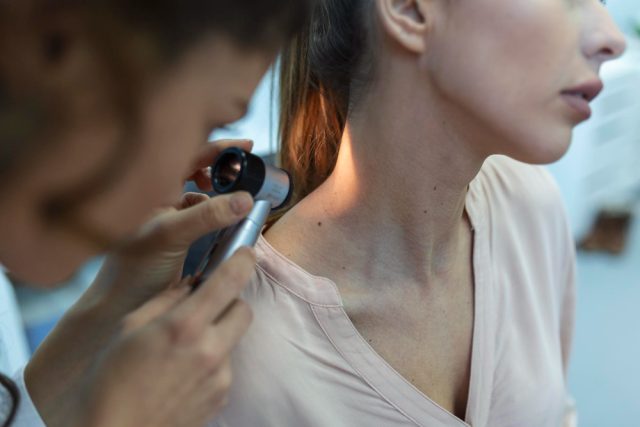Remove Black Spots On The Back And Neck
People worldwide have always wanted to keep their skin free of spots. One skin problem that makes this hard to do is having black spots on the back, neck, and around the shoulders. Most black spots are harmless. Many things can cause them, from simple sunspots to skin cancers that may need immediate care. It’s important to see a dermatologist in Roorkee who can figure out what’s causing these black spots and recommend a good way to get rid of them.
Black Spots On The Back And Neck
People often think that dark spots on the neck, back, and shoulders are just dirt that they can wash off. But these black or dark spots are signs of hyperpigmentation, a condition in which patches of skin get darker than the normal skin around them. Even though they can appear anywhere on your body, dark spots usually show up in places that get the most sun.
Why do my back and neck have black spots?
Many things can cause dark spots on the back and neck, like:
Excessive exposure to UV rays: Dark spots on the back and neck can be caused by overexposure to UV rays. It can happen if you spend too much time in the sun without enough sun protection or if you use tanning beds too much. This is because the skin is making too much melanin.
Dark spots on the neck and back can be caused by Riehl’s melanosis, acne, macular amyloidosis, lichen planus pigments, and other skin conditions.
Solar lentigines, also called liver spots, are dark spots that often appear on people over 40.
Acanthosis Nigricans: This condition usually affects the neck and other folds of the body, such as the underarms. The skin looks like a dirty neck because it is soft and thick. It happens when people gain too much weight, and their insulin hormones don’t work right.
Side effects of Medications: Taking drugs like Tetracyclines, Phenytoin, Sulfonamides, Estrogens, Amiodarone, Phenothiazines, etc. can cause black spots on the back and shoulders.
Dark spots on the back can be caused by health problems like liver disease, Addison’s disease, Pituitary tumors, hemochromatosis, etc.
Black spots on the back, neck, and shoulders have these signs:
Read on what the black spots on your back, neck, and shoulders look like.
- The dark spots can be dark brown, black, or slate grey in color.
- They don’t hurt.
- A black spot’s texture can be smooth or bumpy, just like the skin around it.
- Most solar lentigines are flat and oval-shaped.
How to Get Rid of Black Spots on Your Back and Neck?
Depending on the cause, a dermatologist may use any of the following to get rid of the black spots on your back and neck:
Laser Treatment: In this procedure, laser light is used to break up the pigment in a targeted way. Cells that cause black spots on the back and neck also speed up the production of collagen, which helps the body heal faster. It works well as a way to get rid of dark spots.
Chemical Peels: Different kinds of chemical peels can help you get rid of dark spots. The alpha and beta hydroxy acids in these peels come from natural sources and vary in strength. They work by sloughing off dead skin cells and removing pigment buildup in the top layers of the skin. Glycolic and trichloroacetic peels are two of the best chemical peels for treating dark spots.
Microneedling is a common way to treat dark spots because it doesn’t involve chemicals and helps the body heal itself. It involves using a hand-held device with several tiny needles that help the skin make more collagen.
Dermabrasion is a procedure that uses a wire or an instrument with a diamond tip to remove layers of skin without pain. Dermabrasion is a good way to get rid of spots that go deeper than the epidermis (top layer of skin).
Skin-lightening creams: There are a lot of skin-lightening creams on the market. They can help eliminate some kinds of dark spots if you use them correctly and for as long as your dermatologist says. Hydroquinone is one of the most common ingredients in these creams that make the skin lighter. They also have Kojic Acid, Lactic Acid, Glycolic Acid, Azelaic Acid, etc. Even though these creams might help, they usually only work for a short time. They have to be used under the guidance of a Dermatologist.
Summary
Dark spots commonly occur as people age. They are often caused by having been in the sun. But they can also be caused by certain skin conditions, medicines, and medical problems.
Your doctor or dermatologist can often tell what’s wrong with dark spots just by looking at them. But sometimes, to be sure, they may do a skin biopsy.
Most dark spots are harmless. Still, some people choose to have them removed because they want to look better. Lightening creams and cosmetic procedures can be used to treat skin discoloration.
You might not be able to get rid of all dark spots. But you can lower your risk by using sunscreen, staying covered when you are in the sun, and staying out of the sun during peak hours.
A Word From Verywell
Even if you don’t think anything strange about your skin is dangerous, you should see a dermatologist once a year for a skin checkup. Even though a dark spot is probably nothing to worry about, keep in mind that changes in your skin color can sometimes mean you have cancer. This is especially true if there are other changes, like bleeding, itchiness, or redness.
In rare cases, what looks like a sunspot, such as a solar lentigo, may be lentigo maligna, a type of melanoma.

